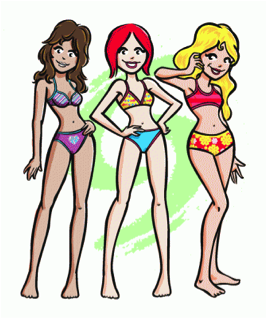 In 2009 and 2010, 3 naked ladies talked about their view from the stages and laps of the 70′s, 80′s, 90′s and the aughts.
In 2009 and 2010, 3 naked ladies talked about their view from the stages and laps of the 70′s, 80′s, 90′s and the aughts.
For as a long as there’s been music, women have danced for the entertainment and titillation of men. Scheherazade. Minsky’s Burlesque. Cage dancing go-go girls in the psychedelic 60′s. Times Square strippers, pole dancers and lap dancers. Women dance….Men watch.
This entry was originally written and posted on September 7, 2009 on the now defunct dirtygirldiaries.com. The ladies deserve a re-run.
Rachel Aimee: I think there’s this myth among dancers that the industry is “going downhill” and that dancers across the board are expected to do more than they used to do. I know women who have been working since the 90s and refer to that decade as the “golden age of stripping,” when dancers got paid tons of money just to dance on stage and didn’t even have to touch the customers, but it seems, from what I’ve read on both your blogs, that dancers have been doing more than just dancing for a long time.
Lauri Shaw: Yes, and in the 90s there were girls who said the same thing about the 80s. Jodi, in “Lele” (your story from Soft Skull anthology Hos, Hookers, Call Girls, & Rent Boys), a customer is going down on a dancer while she sits on the stage, collects his money, and otherwise ignores him. Was it common for dancers to allow so much contact?
Jodi Sh Doff: In the late 70’s there was a lot less regulation. It was years before AIDS reared its ugly head. Tourists, particularly Japanese businessmen, could come off the plane at Kennedy airport, hand a cabbie a slip of paper with just the word “Cookie” on it. Places like the Cookie Jar and Winks were standing room only, bottomless, with stages no higher than, well, than your dinner table. Girls were there for your dining and dancing pleasure, hot lunches they used to be called. The money was insane and there was no hustle. You couldn’t sit and drink with a customer — there was no room. Unfortunately for me, I got my first close up look at a vagina that was not attached to me and took off on the first day. Had I known, I’d have gotten real comfortable, real fast. By the early 80’s the Alcoholic Beverage Control (ABC) code called the shots and if a club served booze, the girls had to be a minimum of six feet away from the customers and they had to have g-strings. No pulling aside the g-string (although girls did), no touching yourself or them (of course we did that too). That’s when a lot of stages moved behind the actual bar. Diamond Lils was a renegade bar, hence the lack of register tape or financial records of any kind.
RA: Yes, you couldn’t get away with anything like that at clubs I’ve worked at, but I think it’s the norm for lapdances to be pretty heavy contact and sometimes include “extras” (hand jobs, etc.), especially in private rooms. Then of course there are plenty of dancers who just dance and don’t do anything illegal.
LS: All of that’s true, in fact last year Scores lost its liquor license after getting busted for prostitution in 2007. But in the 90’s, blatant tricks didn’t happen out in the open like that, out on stage for everyone to see. The rule was generally “no touching the girls onstage.”
RA: I’ve also heard cops arresting dancers just for allegedly agreeing to perform an illegal act. In cases where dancers get busted, of course the clubs never take any responsibility, even if they knew perfectly well what was going on and may have been making money off it.
LS: I do remember one place where a scenario like at Diamond Lils might have flown — the Harmony Theatre. I was only there once. They kept it really dark and made no pretense of being “entertainers.” I don’t think they even bothered serving drinks. I do not remember there being a bar at all. Men sat in those theatre seats and haggled with the girls over the price of a lapdance, which was often a euphemism for a hand job or more.
JshD: The original Harmony was uptown, on 48th Street, right by the Gaiety Burlesque. The Gaiety was an all male dance house with live sex shows and a lot of action going on back stage between sets. Working girls used to hang out in the back rows just to get off their feet for a while. It was a blast, I had a few guy friends who worked the Gaiety. But the Harmony used to be specialty acts, old school star strippers and girls that could pick a dollar up off the table with their cooch. Very impressive if you ask me. I believe the name was changed to the Melody Burlesque and then the Harmony re-opened downtown and it was that free-for-all you’re talking about. All lap dancing, no pretense of being “entertainment” at all.
LS: Exactly, it was a free-for-all. Men could buy anything they wanted at the Harmony, and working girls could buy the freedom to give the men whatever they wanted. There wasn’t a bouncer in sight. The shift manager sat in the coat room, away from all the action.
RA: I’ve never worked at a place that was that free and easy, but I’ve definitely preferred working at clubs where management was more hands-off. At some of the big corporate “gentlemen’s clubs” that have taken over modern day Manhattan, management are constantly micromanaging everything the dancers do, policing lapdances and pressuring dancers to take customers to private rooms (because they make a huge cut). I think most dancers prefer the freedom to decide for themselves what they’re comfortable with. But in general I find it’s very difficult to have open conversations about who does what in strip clubs because it’s so easy to offend people. There’s so much stigma attached to sex work that it’s easy to unintentionally make someone feel bad if you’re not willing to do something that they are willing to do. Everyone has different boundaries, so I think that tension is always going to exist in the industry.

